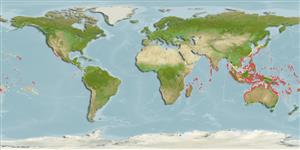>
Gobiiformes (Gobies) >
Gobiidae (Gobies) > Gobiinae
Etymology: Valenciennea: From Achille Valenciennes 1794-1865; he worked with Duméril, Cuvier and Lacepède since 1815; malacologist, author of a "Histoire naturelle des poissons" (Ref. 45335); parva: Species name from the Latin 'parvus', meaning dwarf..
More on authors: Hoese & Larson.
Environment: milieu / climate zone / depth range / distribution range
Ecologia
marinhas associadas(os) a recifes; intervalo de profundidade 1 - 20 m (Ref. 90102). Tropical
Indo-Pacific: Ashmore Reef, Maldives, and Seychelles to Oceania, north to Ryukyu Islands, south to the Great Barrier Reef.
Tamanho / Peso / Idade
Maturity: Lm ? range ? - ? cm
Max length : 10.0 cm SL macho/indeterminado; (Ref. 48637)
Espinhos dorsais (total): 6 - 7; Raios dorsais (total): 12; Espinhos anais 1; Raios anais : 12. Characterized by pale grey body color; lower half of body with a pair of stripes linked by diffuse dark bars; faint dark grey bars/saddles on back; presence of blue-white stripe below eye to edge of gill opening, continued as white spot on upper pectoral fin base; without filamentous dorsal spines; rounded and short caudal fin, about equal to head length; longitudinal scale series 67-85; ctenoid body scales, becoming cycloid anteriorly below anterior part of first dorsal fin; without scales on head or midline of nape; side of nape with scales extending forward slightly anterior to above upper end of gill opening; scaleless pectoral fin base; partly scaled or scaleless prepelvic area; depth of body 5.7-6.6 in SL (Ref. 90102).
Inhabits coastal and inner reef sand flats and slopes, often in large lagoons (Ref. 48637). Found normally over clean, medium-grained sand patches interspersed with coral heads. It shares its habitat with the larger species such as V. longipinnis. Occurs in pairs or small groups and has been observed in burrows. Monogamous (Ref. 52884). Observed to rock back and forth when moving near the burrow.
Ciclo de vida ou comportamento de acasalamento
Maturidade | Reprodução | Desova | Ovos | Fecundidade | Larvas
Monogamous mating is observed as both obligate and social (Ref. 52884).
Hoese, D.F. and H.K. Larson, 1994. Revision of the Indo-Pacific gobiid fish genus Valenciennea, with descriptions of seven new species. Indo-Pac. Fish. (23):71 p. (Ref. 8527)
Status na Lista Vermelha da UICN (Ref. 130435)
Ameaça para os humanos
Harmless
Uso pelos humanos
Mais informação
ReferênciasAquaculturaPerfil para aquaculturaEstirpesGenéticaElectrophoresesHereditariedadeDoençasProcessamentoNutrientsConversão de massa
Ferramentas
Relatórios especiais
Baixar XML
Fontes da internet
Estimates based on models
Preferred temperature (Ref.
123201): 24.6 - 29.3, mean 28.3 °C (based on 2546 cells).
Índice de diversidade filogenética (Ref.
82804): PD
50 = 0.5000 [Uniqueness, from 0.5 = low to 2.0 = high].
Bayesian length-weight: a=0.01023 (0.00477 - 0.02194), b=3.02 (2.84 - 3.20), in cm total length, based on LWR estimates for this (Sub)family-body shape (Ref.
93245).
Nível Trófico (Ref.
69278): 3.2 ±0.3 se; based on size and trophs of closest relatives
Resiliência (Ref.
120179): Elevada, tempo mínimo de duplicação da população menor que 15 meses (Preliminary K or Fecundity.).
Fishing Vulnerability (Ref.
59153): Low vulnerability (10 of 100).
Nutrients (Ref.
124155): Calcium = 118 [63, 235] mg/100g; Iron = 0.803 [0.422, 1.464] mg/100g; Protein = 18.4 [16.4, 20.1] %; Omega3 = 0.142 [0.066, 0.245] g/100g; Selenium = 20.3 [11.2, 39.2] μg/100g; VitaminA = 138 [38, 430] μg/100g; Zinc = 2.02 [1.36, 2.97] mg/100g (wet weight);
